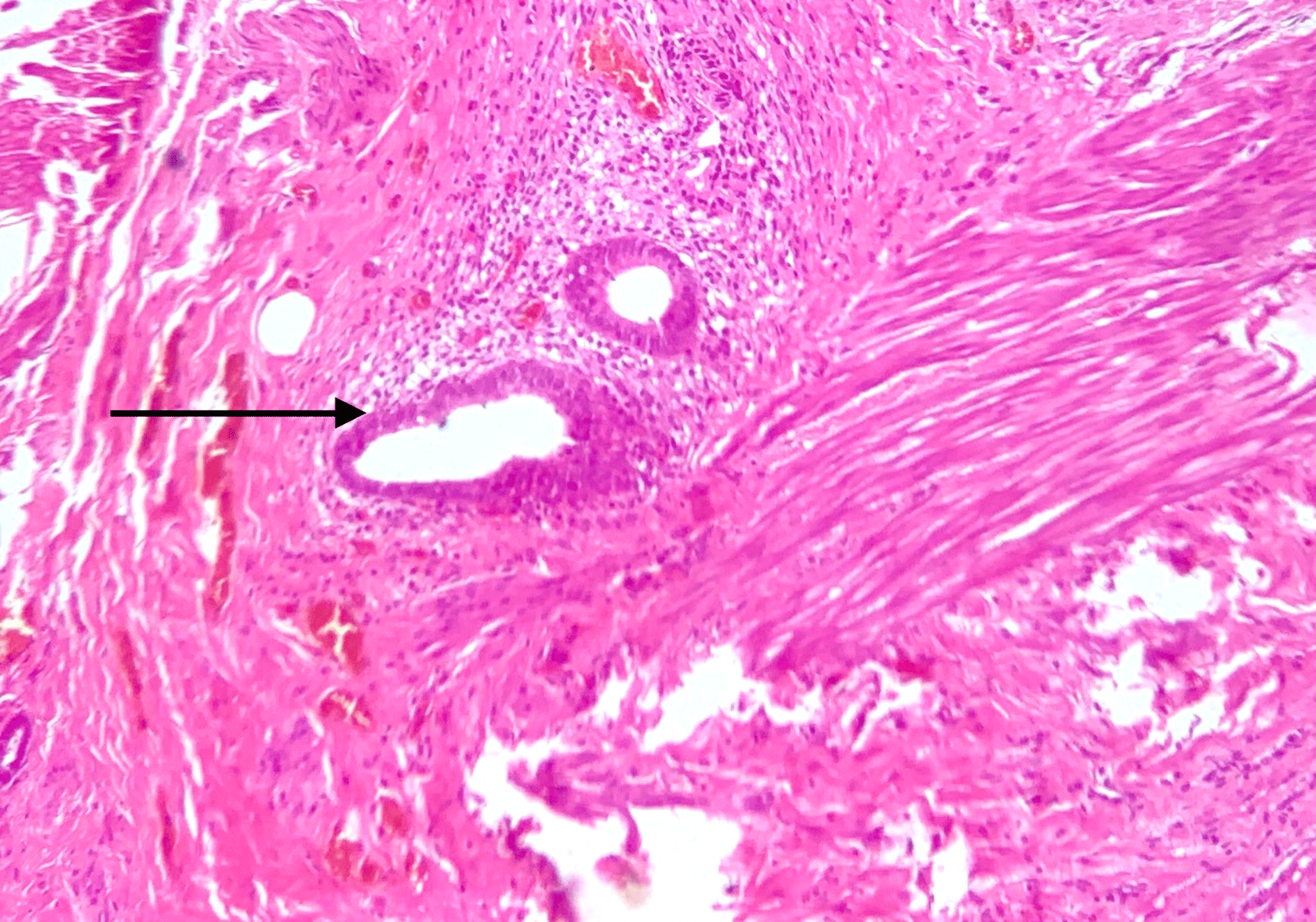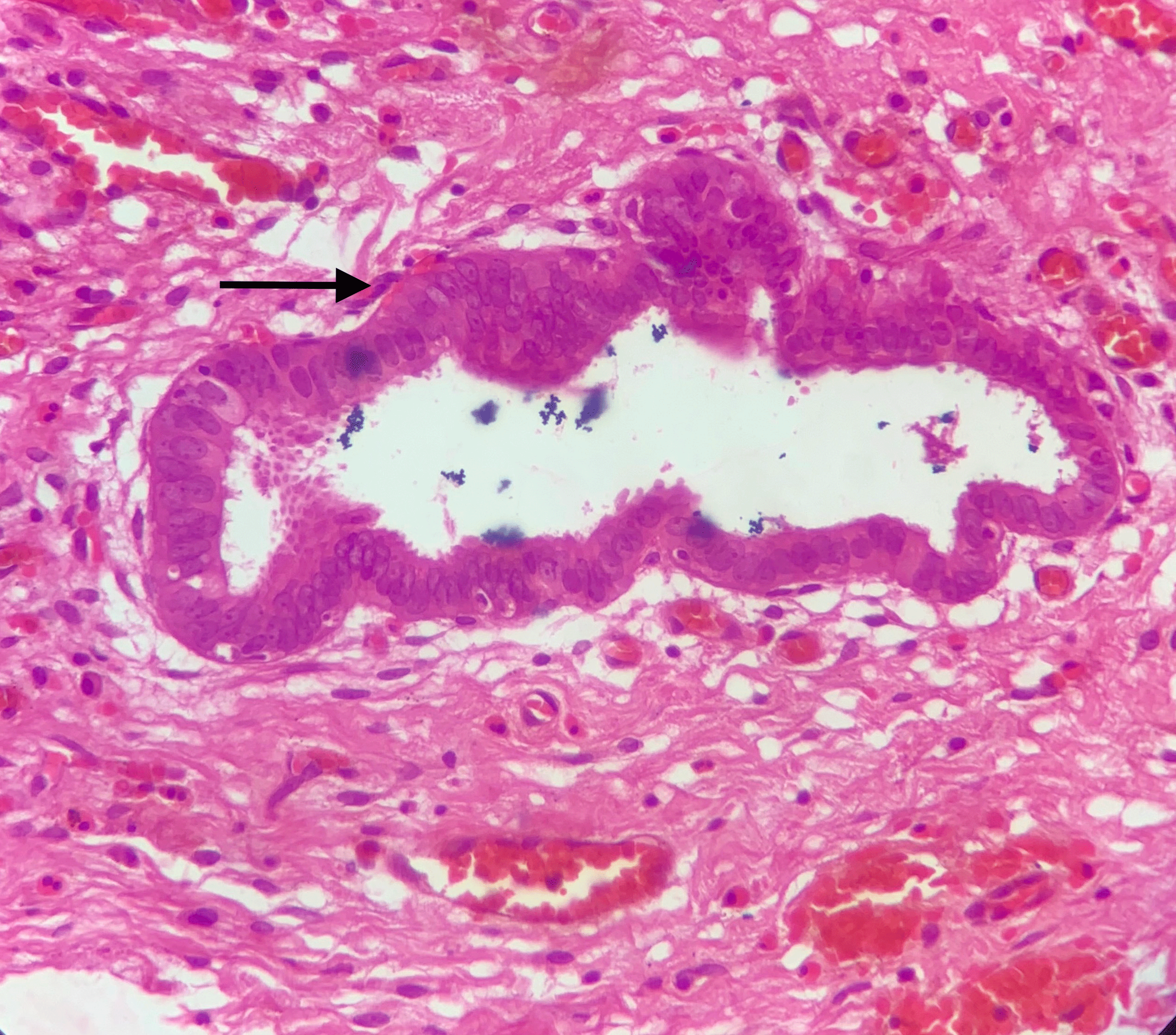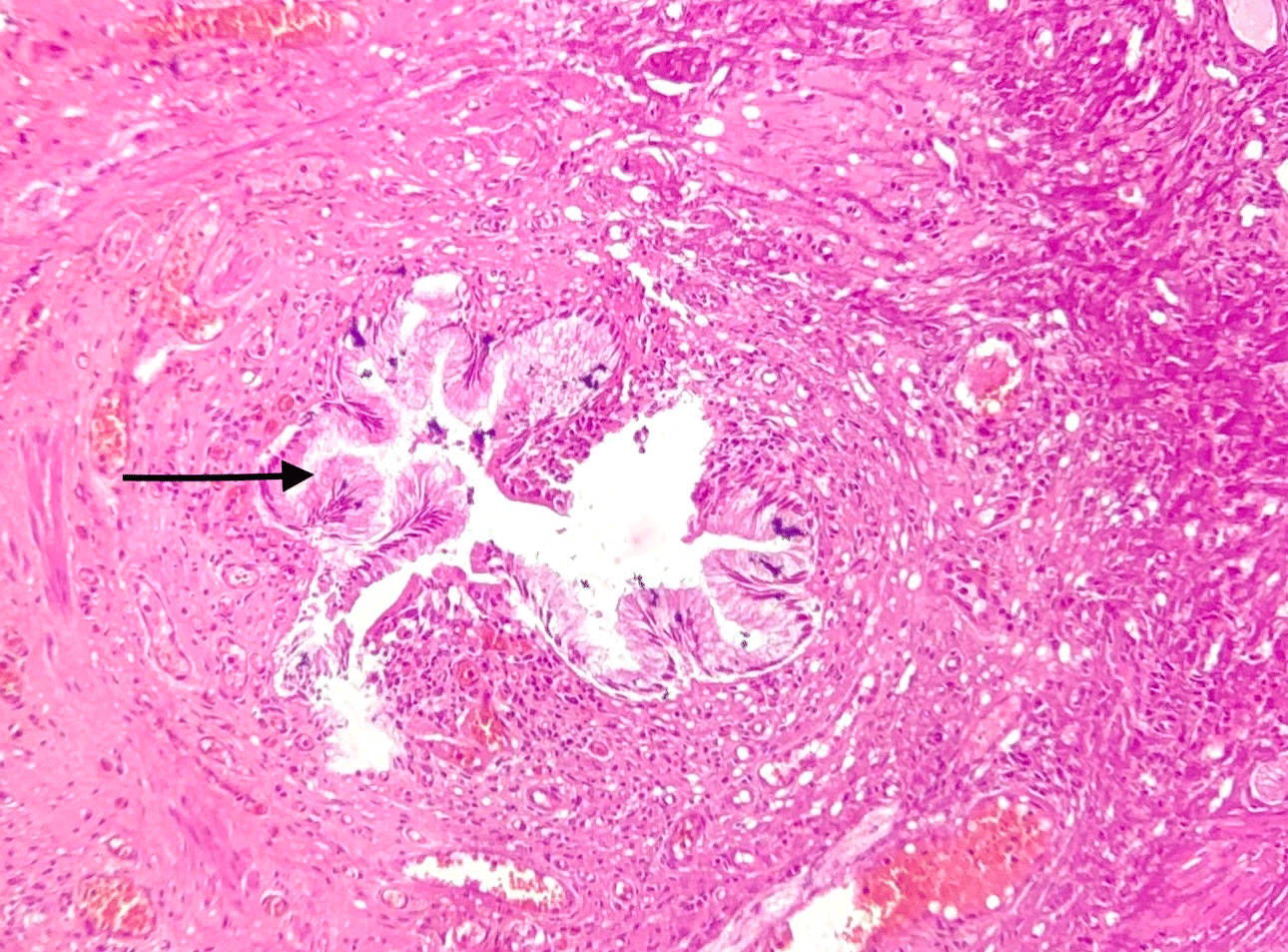Archive of Urological Research
Mullerianosis of the urinary bladder: A great mimicker
Kavita Mardi1* and Supriya Verma2
2Senior Resident, Department of Pathology, Indira Gandhi Medical College, Shimla, India
Cite this as
Mardi K, Verma S (2024) Mullerianosis of the urinary bladder: A great mimicker. Arch Urol Res 8(1): 005-007. DOI: 10.17352/aur.000048Copyright
© 2024 Mardi K, et al. This is an open-access article distributed under the terms of the Creative Commons Attribution License, which permits unrestricted use, distribution, and reproduction in any medium, provided the original author and source are credited.Mullerianosis is a rare benign lesion consisting of an admixture of two or more of the following tissues: endometriosis, endocervicosis, and endosalpingiosis. It most commonly affects the urinary bladder and females of reproductive age group. Müllerianosis of the bladder is an extremely rare entity with fewer than 30 cases reported. Herein we report one such rare case of mullerianosis of the urinary bladder in a 33-year-old female who had undergone cesarian section 2 years back, presented with painless hematuria associated with menstruation. USG revealed a soft tissue lesion measuring 23×11 mm abutting the wall of the urinary bladder and extending into it. These findings were suspicious for endometriosis. The patient was admitted to the hospital for transurethral resection of a bladder lesion (TURBT). Operative findings revealed a solid 2x2 cm mass in the posterior wall of the urinary bladder. Superficial and deep TURBT chips were sent for histopathological examination. On microscopic examination, there were variable-sized glands lined by endometrial, endocervical, or tubal epithelium embedded in the bladder wall. The case was diagnosed as mullerianosis of the urinary bladder. As this rare entity, since it mimics benign and malignant neoplasms clinically and radiologically, pathologists should be aware of this rare entity to avoid misdiagnosis, which has great therapeutic implications for the patient.
Introduction
The urinary bladder is the most common site of the urinary tract affected by endometriosis. Endocervicosis and endosalpingiosis mean the presence of endocervical glands and glands lined by tubal epithelium respectively and these can also be found in the urinary bladder. A combination of two or more of these tissues is termed mullerianosis. This term was first coined by Young and Clement in 1996 [1]. It is a rare benign lesion that is mostly reported in the urinary bladder [1-3]. They can also be seen in the ureter, spinal cord, inguinal lymph nodes, and mesosalpinx [2]. This lesion is most commonly found in reproductive-age females and presents clinically as pelvic pain, dysuria, and hematuria which may or may not be associated with menstruation. Approximately 35 cases of mullerianosis of the urinary bladder have been reported in the literature so far [3-5]. Herein we report a case of mullerianosis of the bladder in a 33-year-old female who presented with painless hematuria during menstruation. It is important to recognize this lesion because it mimics several other benign and malignant lesions of the bladder clinically, radiologically, and histologically.
Case history
A 33-year-old female presented with painless hematuria during the menstrual cycle. She had a history of LSCS (lower segment caeserean section). USG revealed evidence of a suspicious defect in the anterior uterine wall measuring up to 12 mm with hyperechoic soft tissue measuring 23×11 mm abutting the wall of the urinary bladder and extending into it, findings were suspicious for endometriosis. The patient was admitted to the hospital for transurethral resection of a bladder tumour (TURBT). Operative findings revealed a solid 2×2 cm mass in the posterior wall of the urinary bladder. Superficial and deep TURBT chips were sent for histopathological examination. Microscopy revealed varied findings comprising of von Brunns nests, cystitis cystica, cystitis glandularis along with few endometrial glands surrounded by stroma (endometriosis), (Figure 1) glandular and cystic spaces lined by columnar mucin secreting endocervical epithelium (endocervicosis) (Figure 2) and tall columnar ciliated tubular epithelium (endosalpingiosis) (Figure 3). All these structures were haphazardly embedded in lamina proper and musclaris propria. No atypia/mitotic figures were identified. The final histopathological diagnosis was given as Urinary bladder mullerianosis.
Discussion
Mullerianosis is a rare lesion of the urinary bladder described as an admixture of two or more Mullerian tissues (endometrial, cervical, tubal) in the urinary bladder’s lamina propria and muscularis propria. It was first described by Young and Clement in 1996 [1]. This lesion can also occur in sites other than the bladder like the ureter, spinal cord, inguinal lymph nodes, and mesosalpinx [2]. It is of utmost importance to be aware of this entity as it mimics neoplastic lesions of the bladder from clinical as well as cytological and histological aspects. To date, only 30 cases of mullerianosis of the urinary bladder have been reported in the literature [3].
The exact pathogenesis of mullerianosis is still controversial. Many theories have been put forward to explain its occurrence. The two main ones are the implantation theory and the metaplastic theory. The implantation theory states that the Mullerian tissue becomes implanted within the bladder during operative procedures like pelvic surgery or the caesarian section. However, this theory fails to explain mullerianosis in people with no history of prior surgery, or mullerianosis in other distant sites. On the other hand, the metaplastic theory suggests that the presence of multiple types of tissue in the bladder results from the differentiation of Mullerian epithelium into endometrial, endocervical, and tubal types. In addition, mullerianosis of the bladder is limited exclusively to its posterior wall and dome, a place that is related to peritoneal covering and is extremely sensitive to female hormones. According to Branca, et al. [2] it was suggested that peritoneal mesothelium develops from the secondary Mullerian system and may retain its ability to differentiate into different types of tissue including endometrial, endocervical, and tubal [6]. Koren, et al. [7] reported a case in which tubular epithelium was in continuity with urothelium in cystitis cystica and cystitis glandularis, and all these cells were positive for estrogen and progesterone receptors, thus strongly favouring metaplastic theory. In general, metaplastic theory is preferred over implantation theory. But in the present case, there was a clear-cut history of the cesarian section and USG revealed a suspicious defect in the anterior uterine wall measuring up to 12 mm with hyperechoic soft tissue measuring 23×11 mm abutting wall of the urinary bladder and extending into it. These findings clearly favor the implantation theory.
Mullerianosis of the urinary bladder mostly occurs in females of reproductive age groups ranging from 28 to 55 years [2]. It presents with nonspecific symptoms such as pelvic pain, hematuria, and lower urinary tract symptoms, mainly dysuria and polyuria. Symptoms are often cyclical and coincide with the menstrual cycle [8]. A history of pelvic surgery is associated in about half of cases [9]. Few cases of mullerianosis have also been reported in male patients, especially in men with prostate cancer receiving estrogen therapy. It typically affects the lower genitourinary tract [10].
On cystoscopy, the lesion presents as a polypoid mass in the urinary bladder or internal cystic structures that appear as dark blue to black cysts. There may be associated scarring and fibrosis with distortion of the bladder wall, which raises suspicion of a malignancy [6]. Grossly, mullerianosis is seen as a polypoid mass involving the dome or posterior wall of the bladder ranging from 1 to 4.5 cm in size.
Histologically, they appear as variable-sized glands and cysts in the lamina propria and muscularis propria which are lined by tubal, endocervical, and endometrial epithelium. The endometrial-type glands are often surrounded by endometrial-like stroma. Sometimes, foci of urothelium may also be found in the glands along with Mullerian tissue. In our case also there were von burn nests and cystitis cystica/glandularis in addition to mullerianosis. On immunohistochemistry, estrogen and progesterone receptors are positive, which makes this tumor sensitive to hormones. The glandular component also stains positive for CA-125. Stromal endometrial-like tissue is positive for anti-CD10 antibody [2].
Differential diagnoses of urinary bladder mullerianosis include a spectrum of benign to malignant lesions that includes cystitis glandularis, cystitis cystica, urachal remnants, nephrogenic adenoma, bladder adenocarcinoma, and direct spread from cervix adenocarcinoma [9]. In contrast to mullerianosis, cystitis cystica, cystitis glandularis, and nephrogenic adenoma are superficially located in the lamina propria of the bladder wall with preservation and no involvement of the muscularis propria. These lesions are also negative for estrogen and progesterone receptors [8]. Urachal remnants are frequently observed near the dome of the bladder and they are negative for CD 10 staining in contrast to mullerianosis [2]. Adenocarcinoma of the cervix infiltrating bladder wall can be ruled out by examination and imaging of the cervix [10]. Bladder adenocarcinoma can also have an infiltrative growth pattern with the involvement of muscularis propria, however, in contrast to mullerianosis, the glands show significant nuclear atypia, mitotic activity, and stromal reaction [8].
The preferred treatment modality for bladder mullerianosis depends upon the age of the patient, the location within the bladder, and the size, number, and depth of infiltration [11]. The treatment of choice for urinary bladder mullerianosis is extensive endoscopic transurethral resection. It is recommended to regularly follow up with the patient as recurrence has been reported. In cases with recurrence, repeat cystoscopy and resection may be needed [8]. Malignant transformation of mullerianosis of the bladder is extremely rare with only one reported case of endometrioid carcinoma in literature [12].
Conclusion
Urinary bladder mullerianosis assumes significance as it mimics neoplasm clinically and radiologically. However, a thorough histological examination is helpful in differentiating this rare lesion from malignancy. It is important to raise awareness of such an entity in order to avoid misdiagnosis and unnecessary radical procedures. Though rare, mullerianosis should be kept in the differential in the diagnosis of urinary bladder masses.
- Young RH, Clement PB. Müllerianosis of the urinary bladder. Mod Pathol. 1996 Jul;9(7):731-7. PMID: 8832555.
- Branca G, Barresi V. Müllerianosis of the urinary bladder: a rare tumorlike lesion. Arch Pathol Lab Med. 2014 Mar;138(3):432-6. doi: 10.5858/arpa.2012-0681-RS. PMID: 24576037.
- Sancheti S, Somal PK, Chaudhary D, Khandelwal S. Mullerianosis of urinary bladder: The great impersonator. Indian J Pathol Microbiol. 2020 Oct-Dec;63(4):627-629. doi: 10.4103/IJPM.IJPM_726_19. PMID: 33154321.
- Kumar M. Urinary Bladder Mullerianosis Causing Recurrent Abdominal Pain: A Rare Case Report and Review of the Literature J Health Allied Sci NU. 2024; 14:133.DOI https://doi.org/ 10.1055/s-0043-1764360.
- Fakhralddin SS, Mahmood SN, Qader DK, Ali AA, Kakamad FH, Salih AM, Abdullah HO. Mullerianosis of the urinary bladder; A case report. Int J Surg Case Rep. 2021 Jun;83:106040. doi: 10.1016/j.ijscr.2021.106040. Epub 2021 May 26. PMID: 34102604; PMCID: PMC8187240.
- Maeda K, Kojima F, Ishida M, Iwai M, Kagotani A, Kawauchi A. Müllerianosis and endosalpingiosis of the urinary bladder: report of two cases with review of the literature. Int J Clin Exp Pathol. 2014 Jun 15;7(7):4408-14. PMID: 25120826; PMCID: PMC4129061.
- Koren J, Mensikova J, Mukensnabl P, Zamecnik M. Mullerianosis of the urinary bladder: report of a case with suggested metaplastic origin. Virchows Arch. 2006 Aug;449(2):268-71. doi: 10.1007/s00428-006-0153-1. Epub 2006 Jul 11. PMID: 16832656.
- Olivia Vella JE, Nair N, Ferryman SR, Athavale R, Latthe P, Hirschowitz L. Müllerianosis of the urinary bladder. Int J Surg Pathol. 2011 Aug;19(4):548-51. doi: 10.1177/1066896911409578. Epub 2011 Jun 1. PMID: 21632636.
- Young RH. Tumor-like lesions of the urinary bladder. Mod Pathol. 2009 Jun;22 Suppl 2:S37-52. doi: 10.1038/modpathol.2008.201. PMID: 19494852.
- González RS, Vnencak-Jones CL, Shi C, Fadare O. Endomyometriosis ("Uterus-like mass") in an XY Male: Case Report With Molecular Confirmation and Literature Review. Int J Surg Pathol. 2014 Aug;22(5):421-6. doi: 10.1177/1066896913501385. Epub 2014 Mar 19. PMID: 24651910.
- Whitworth SA, Subhawong AP, Rosenthal DL, Ali SZ. Clear cell adenocarcinoma of the lower urinary tract: cytopathologic characteristics and differential diagnoses. Cancer Cytopathol. 2012 Oct 25;120(5):308-12. doi: 10.1002/cncy.21197. Epub 2012 Apr 19. PMID: 22517612.
- Garavan F, Grainger R, Jeffers M. Endometrioid carcinoma of the urinary bladder complicating vesical Mullerianosis: a case report and review of the literature. Virchows Arch. 2004 Jun;444(6):587-9. doi: 10.1007/s00428-004-1010-8. Epub 2004 Apr 23. PMID: 15221475.
Article Alerts
Subscribe to our articles alerts and stay tuned.
 This work is licensed under a Creative Commons Attribution 4.0 International License.
This work is licensed under a Creative Commons Attribution 4.0 International License.





 Save to Mendeley
Save to Mendeley
